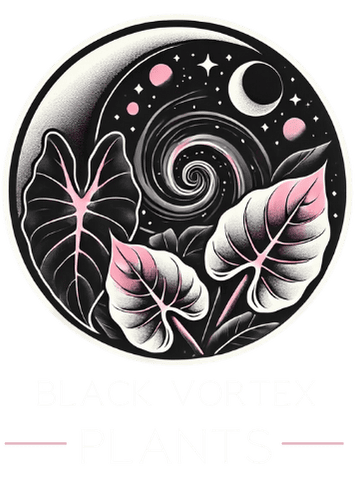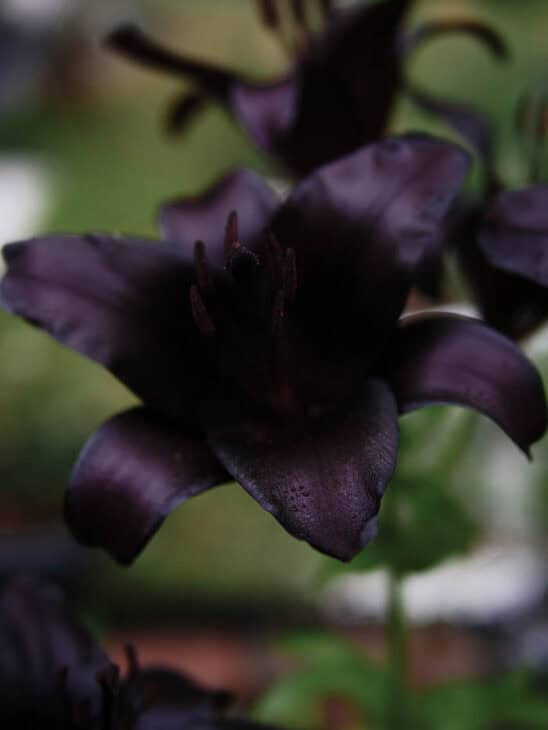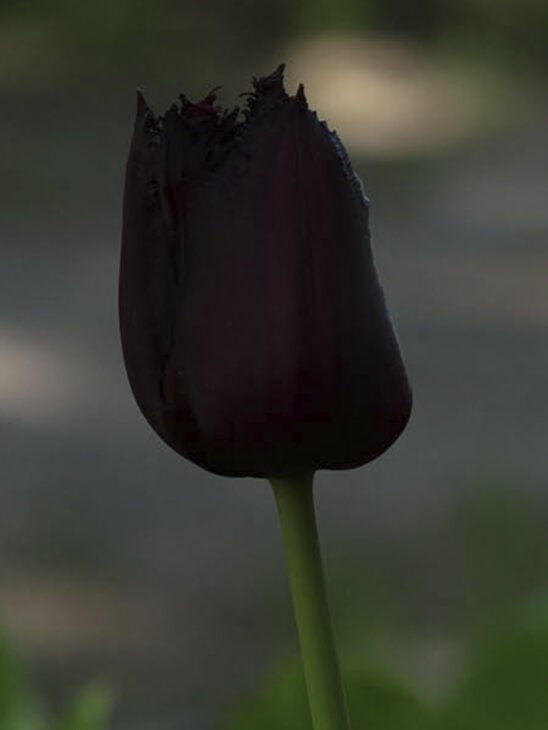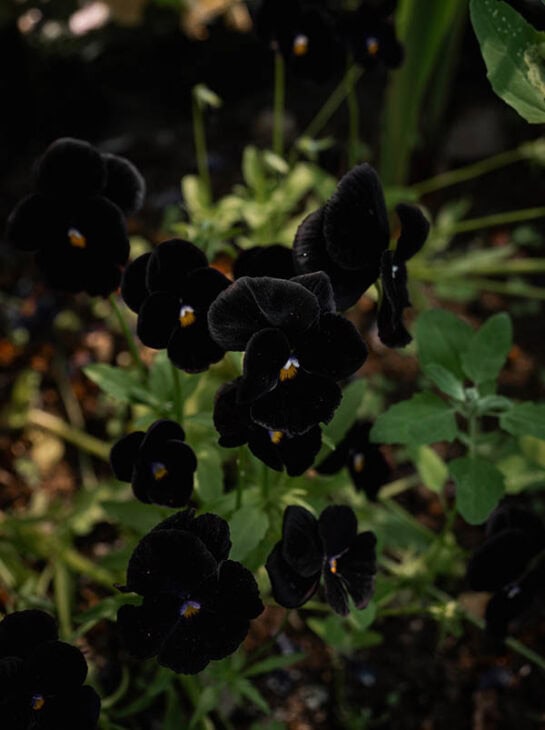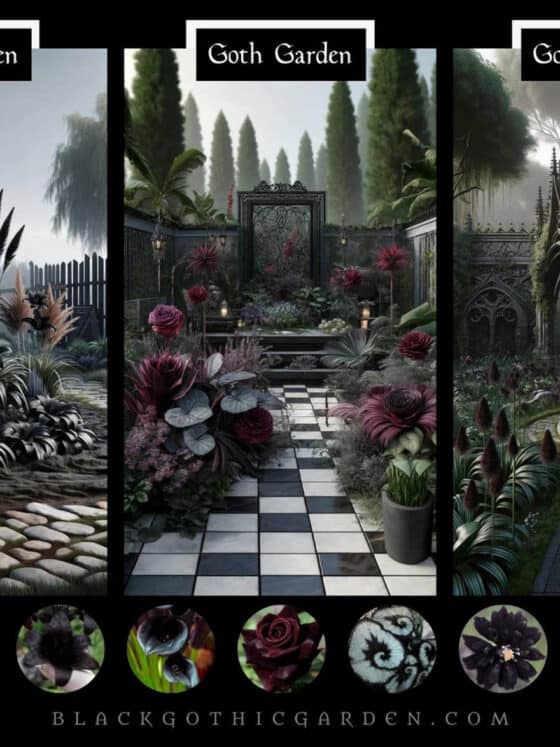Imagine a garden where all the flowers are black or at least dark-toned. Where you see a dark-leafed tree and even encounter black grass. A garden that could be straight out of a Tim Burton movie. This is not an impossible idea at all; today, humans have bred a vast number of dark plant varieties. When I first learned about the existence of black plants and that there were so many that you could even create an entire themed garden, I fell in love with the concept of a black garden or Gothic garden. Let's talk a bit about what a goth garden is all about!
Share
What is Goth Gardening?
Goth gardening, which can be also called as gothic gardening or black gardening, depending on the nuance, is a unique horticultural style that focuses on remarkably dark flowers and plants.
Additionally, it can be complemented with features of Gothic architecture or other decorations associated with a more somber lifestyle.
In other words, a Gothic garden embraces a dark and brooding character by blending gardening with Gothic aesthetics. These gardens draw inspiration from macabre and mysterious themes. The idea of a black garden is quite distinct compared to traditional gardens with their pastel blooms and cheerful gnomes. (Garden gnomes are certainly not my thing!)
In a Gothic garden, the plants and decorations tell a story of mystery and, in a way, a subtle rebellion. The dark aesthetic deeply resonates with those who appreciate the darker side of beauty. Furthermore, black is a rare color in nature, which is why it is perceived as exceptional, enigmatic, and sometimes, in my opinion, unfairly associated with negativity or gloom. (Ugh!)
Historically, Gothic gardens were a concept of their own. Today’s Gothic gardens, however, have evolved to combine rich historical themes with modern aesthetics. While they remain true to their roots, embracing the aesthetics of decay and the supernatural, they can also feature more contemporary decorative elements. You might say that Gothic gardens are fascinating because they merge the cycle of life and death with the charm of the world and the possibilities offered by the modern era. Although elements of Gothic architecture can inspire the design of a Gothic garden, no one can truly argue that black/Gothic gardens are historical—very few black plants even existed before the 2000s.
Why Are People Fascinated by Black Gardens?
There are many reasons why some people – like me – are drawn to dark flowers and plants. Here are a few:
- Rarity and Elegance: The rarity of natural black flowers adds to their allure, symbolizing elegance and sophistication. We tend to notice what stands out from the norm, and black plants certainly provide that.
- Connection to Gothic Imagery: Black is often associated with modern Gothic aesthetics. Gothic themes, in turn, can be linked to Gothic literature and art, conveying feelings of darkness and melancholy. If someone is drawn to these themes of somberness, which can be associated with black, it’s no surprise that black flowers also seem appealing.
- The Beauty of Black: For some, black simply appears beautiful. I have a black toothbrush, black toothpaste, black furniture, black clothes – so why wouldn’t I embrace the same aesthetic with plants?
- Personal Interpretations: The symbolism of black flowers can be subjective, allowing individuals to assign their own meanings based on personal experiences and beliefs.
- Rebellion: Society often demands excessive positivity. We are told to smile and think happy thoughts, hiding sorrow and pain. Flowers are admired for their colors, and they carry a certain light, “girlish” softness. But a black flower, in a way, turns these themes upside down. When something that is supposed to be colorful, joyful, and delicate is black, it becomes a kind of declaration that the person may think a little differently. Not everything has to be colorful, and we shouldn’t always pretend to be happy. Sometimes, we can embrace our so-called negative emotions, as they are also part of being human.
- Cultural Significance: Black holds different meanings in various cultures; in the West, it is associated with mourning, evil, or death, but in other traditions, it can symbolize luck and protection. Black can also be associated with luxury, wealth, and dignity.
Many of these points resonate with me personally. I’ve always had a deep interest in themes that others might consider darker. The concept of darkness is often misunderstood, and what others may see as the “colors of the night” or something evil, I often see as beautiful. I believe that only by understanding our shadow side can we truly understand ourselves.
Additionally, I’m simply attracted to black, dark grey, and other extremely dark colors. (Okay, I also secretly love pastels like pink, but let’s not get into that just yet…) In general, I’m interested in things that some find controversial.
It’s fascinating how deeply ingrained the idea that black equals evil still is in people. When I showed my black flowers in a gardening group on Facebook, alongside many lovely comments, I also received a few remarks about how outrageous it is to ruin beautiful gardens with black flowers and why everything has to look like a funeral, why bring evil into the garden, and so on. Oh dear…
Goth Garden, Gothic Garden or Black Garden?
All of these terms are essentially close to one another and can be used as synonyms. However, I personally see that each term also carries its own unique nuances and design elements, even though they overlap significantly.
To understand the differences, we must naturally first grasp the key terms. “Goth” refers to a modern subculture that emerged from the post-punk music scene in the late 1970s. It is known for its distinctive style, which includes dark fashion, makeup, and music that deal with themes of melancholy and the macabre. (Yes, I can be counted as part of this subculture.) “Gothic,” on the other hand, refers to a historical style that originated in the medieval period and later evolved, encompassing architecture, literature, and art. It is known for its intricate and dramatic forms, as well as themes of mystery, romance, and the supernatural. Today, the terms “goth” and “gothic” are often connected, as gothic art became linked to the goth subculture when goth music began incorporating themes from gothic art. A good example of this is the song Bela Lugosi’s Dead, where Bauhaus brought the chilling themes of Bram Stoker’s Dracula into their music. “Goth,” originally, referred purely to a musical style, but over time, it evolved into a broader subculture that embraces a dark aesthetic, macabre themes, and a certain melancholic romance—sometimes even direct horror.
- Black Garden – In a black garden, the focus is on flowers and leaves that are predominantly black or dark-hued. This garden style is centered around creating a dark aesthetic through the use of black foliage, flowers, and even black hardscaping materials. A black garden is more about color uniformity and less about cultural or historical references. For example, I started my garden purely as a black garden, without much connection to gothic or goth subculture initially.
- Goth Garden – A goth garden reflects the subculture (“goth”) mentioned earlier. In addition to black vegetation, a goth garden incorporates elements that fit the aesthetic of the modern goth subculture. Think dramatic roses, patterned coleus, and statues that evoke a melancholic yet romantic atmosphere. These gardens may also feature plants in deep purples, reds, and blacks. Not all the plants need to be black, as long as they evoke a mood linked to gothic themes. The philosophy emphasizes personal expression, rebellion against traditional norms, and a celebration of macabre and unconventional beauty.
- Gothic Garden – A modern-day gothic garden draws inspiration from original gothic gardens, classic gothic literature, and architecture, either medieval, gothic revival or Victorian gothic. Gothic gardens may include pointed arches, lancet windows, and intricate stone carvings reminiscent of gothic cathedrals. A typical feature of a gothic garden might be a garden path leading to an impressive statue or fountain. Medieval gothic gardens were often practical, growing medicinal herbs. Later, Victorian gothic gardens conveyed the wealth of their owners and were somewhat “show-off” creations. If you visit such a garden today, you might encounter overgrown sections, time-worn statues, and shadowy alcoves, which speak of past stories and forgotten times. Such gardens were also physical manifestations of gothic literature and art. I see them as a way to bring themes of darkness, romance, and ethereality to life. Today, a gothic garden honors these old architectural and artistic solutions, and a purely gothic garden may not even feature a single black flower. Gothicism wasn’t about color but much deeper philosophical and artistic themes.
Often, when someone chooses the path of dark foliage and flowers, the garden is a blend of all three. But for those who aren’t as interested in philosophy, rebellion, or Edgar Allan Poe, the easiest term that focuses purely on the plants and flowers would likely be “black garden.”
However, if you’d like to know more about this topic, here are some of my deeper thoughts on distinguishing between these garden types.
What are the characteristics of a black / goth / gothic garden?
So, perhaps you’d like to create your own goth garden. What are the basics you should consider when starting?
- Choose Black Flowers: Pick plants that are D A R K! I don’t just mean somewhat dark, but so dark they appear almost black in the shadows. There are plenty of options if you’re willing to search a bit. Lilies, tulips, roses, bachelor’s buttons, irises, and even sunflowers can offer some fantastic options. In theory, if you want to lean more toward a gothic or romantic garden, deep reds, purples, and blues can also fit in beautifully.
- Choose Dark Foliage: Flowers aren’t the only part of the plant that can be black—leaves can be incredibly dark too! For example, elderberry has a lovely variety called ‘Black Lace,’ and the ornamental sweet potato (Ipomoea batatas) offers some gorgeous black variations. Heuchera and coleus are also excellent choices for dark foliage. If you live in warmer areas, consider dark Colocasia esculenta varieties. Sometimes, the shape of the leaf can set the right mood, even more than the color itself. For instance, the spiral-shaped leaves of many begonias remind me of the iconic spiral hill from Nightmare Before Christmas.
- Use Ornate Elements: Incorporate a sense of history. Add a touch of old cemetery atmosphere, or draw inspiration from gothic architecture with carved stone statues and tall rose arches. Use decorative wrought iron gates, statues, and antique garden furniture to create a dark oasis. If you want a slightly more modern twist, you can take inspiration from films. Picture the aesthetic of Beetlejuice—think slanted, exaggerated shapes, asymmetrical paths, and some surreal decorative elements. Even an Alice in Wonderland theme could work. Imagine a chessboard-patterned garden path or a small, whimsical hedge maze.
- Embrace the Patina of Time: Don’t shy away from elements that appear aged. For example, if you have statues in your garden, treat them to encourage the growth of moss, algae, or other natural plant life. Don’t be afraid of broken stone structures—let them become part of the atmosphere. Vines can grow long, giving the garden an ancient, timeless feel.
- Lighting: Lighting can significantly alter the mood. Use gothic-style lanterns, fairy lights, or other lighting options to create atmosphere. You could also consider slightly bluish lighting to enhance the garden’s mystique. Think of Corpse Bride as an example to capture the essence of what I mean.
- Water Features: If you’re not afraid of putting in a bit of extra effort, one of the most impressive additions to a garden is a water feature, such as a fountain, a pond with water lilies, or a mysterious reflecting pool.
Examples of black plants:
Not sure what to look for? One of the easiest ways to start would be black tulips, especially if you are reading this blog post before the fall. You can also scan your local garden houses. But to give some extra inspiration and keywords, here is a list of some black flowers and plants:
– Black Tulip (Queen of the Night)
– Black Rose (Black Baccara)
– Black Dahlia (Arabian Night)
– Black Calla Lily (Black Star)
– Black Hellebore (Onyx Odyssey)
– Black Pansy (Black Beauty)
– Black Petunia (Black Velvet)
– Black Hollyhock (Nigra)
– Black Iris (Before the Storm)
– Black Hyacinth (Dark Dimension)
– Black Peony (Black Beauty)
– Black Scabiosa (Black Knight)
– Black Lily (Landini)
– Black Viola (Molly Sanderson)
– Black Orchid (Fredclarkeara After Dark)
– Black Calla Lily (Schwarzwalder)
– Black Cosmos (Black Magic)
– Black Daylily (Black Emmanuelle)
– Black Snapdragon (Black Prince)
– Black Columbine (Black Barlow)
– Black Cornflower (Black Ball)
– Black Geranium (Purple Ghost)
– Black Sunflower (Black Magic)
– Black Elderberry (Black Lace)
– Black Fritillaria (Fritillaria persica)

